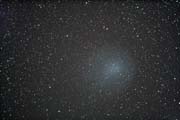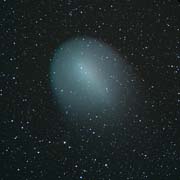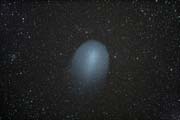In 1892 on November 6th. Edwin Holmes from London, England discovered a new comet which had suddenly burst into life. The following year it was again visible although not so bright, but then subsided into obscurity until October 2007. There is a full history here. The comet was expected to have a magnitude in the region of 17 during October, but suddenly brightened dramatically, first reported by Spanish (Tenerife) observer Juan Antonio Henriquez Santana. Fortunate man!
The astronomical community was electrified by this event - it was virtually unheard of for a comet to brighten so rapidly in such a short time, particularly at its considerable distance from the Sun - well out beyond the orbit of Mars, in the region of the Asteroid belt. That may well offer a clue to the brightening - there's a slim possibility that it may have suffered an impact with a small asteroid. That's my personal favourite explanation! Or of course there may simply have been a build up of pressure of gas below the crust which eventually broke through cataclysmically.
Whatever the reason for the brightening, it rapidly reached a magnitude in the region of 2.5, an increase in brightness of almost one million times, and was easily visible to the naked eye in the constellation Perseus, forming (for Northern hemisphere observers) a backward 'L' with the bright star Mirfak (alpha Persei) and delta Persei. I was experiencing mixed weather when the news reached me, but on the evening of 26th. October I managed to obtain a hurriedly snatched wide field photo through thin cloud with my Canon 350D on a tripod. Unprocessed crop from a single 10 second exposure at ISO 800.
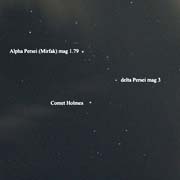
My next opportunity for a photograph came on the following night, 27th. October, when better conditions arrived for a short while. This time I used my SBIG camera on the 12" LX200R with the Astrophysics reducer giving f7. Only short (20 second) frames were required, with this result. Luminance 20 x 20 sec binned 1x1, RGB each 6 x 10 sec binned 2x2.
The top image of course shows the comet in the star field. Full Size.
The middle image is less stretched, better to show the core area.
The rather weird spidery image is the result of applying a Larson-Sekanina rotational gradient filter (rotation 5 degrees) to the image. While this technique can introduce artifacts, it also is able to show up radial features otherwise almost invisible. In this case it is pretty clear that there is an emission region around 5-0-clock.
This is also confirmed by the heavily stretched fourth image (actually from the next image on 28th. October) showing structure in the same area.
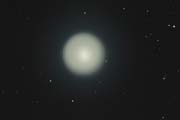
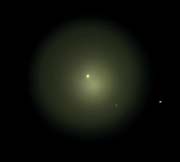
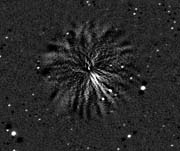
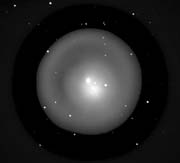
On 28th. October a clear night gave me more opportunities. Top pic colour. Full size.
Two single frames separated by 40 minutes show the slow but steady motion of the comet across the background stars. Because the comet is almost at opposition this apparent motion is quite small - a bonus which helps to reduce any smearing of the background stars in each imaging session. But it means that any tail forming will be heavily foreshortened.
Click here for an animated GIF file showing the motion.
If you can do 'wide eye' 3-D, click here for a layout of the two images to give this effect.
For anyone who hasn't tried this before, you gaze at a point midway between the two images, then try to relax your eyes as though looking into infinity. Then for many, the brain will fuse the two images to give a 3-D effect. It doesn't work for everyone!
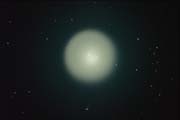
The comet continued to grow but the weather was unkind. But a brief clear spell in the early hours of 31st. October gave me another opportunity.
It's particularly interesting to note that the core is now off centre. Almost certainly Solar wind/photonic pressure is elongating the coma, and a tail could be forming.
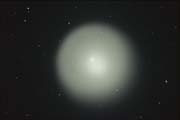
This montage shows the amazing growth over a little more than three days. The diameter of the coma in the latest image is in the region of 400,000 miles! Note that all these images were taken with the same telescope/camera configuration, so are to scale with each other.
For any further images, other than perhaps core detail, I will have to move to a wider angle configuration!
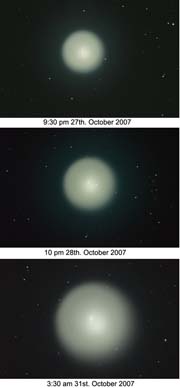
Well, with weather and other committments I had to wait until November 5th before capturing further images. And by this time the comet had expanded hugely, so I had to drop from the (with reducer) 2 metre focal length of my LX200R to the 650 mm fl of my TMB refractor. And even then I used a focal reducer to bring it down even further.
I first took some frames with my Artemis 285 to avoid blooming with my ST8, but realised on processing that as looked likely on 31st. October a tail had formed which was not easily visible in this set of exposures. But they nicely showed the main coma with its delicate blue-green colour. Luminance 10 x 30 sec, RGB each 5 x 30 sec. Mid sequence 2340 UST 5th. November 2007
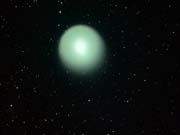
Having realised that the tail capture was lacking, I set up my ST8 camera with its larger chip, and obtained this image which clearly shows a substantial tail, although the field of view was still insufficient to capture the longer trails seen on other photographs on the 'net'. Luminance 8 x 5 minutes, RGB each 4 x 90 secs binned 2x2. Mid sequence 0230 UST 6th. November 2007
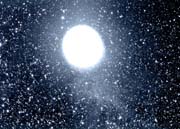
During the above session I also took a couple of sequences with shorter (30 second) exposures. These sequences were approximately 1 hour and 40 minutes apart, and the movement of the comet in that time was sufficient again to produce a 'wide eye' stereo effect. Despite the short exposures, enough data was there to faintly show the tail.

Again a couple of days passed, then a good clear night on 8th. November. This time I reverted to my Artemis with a 135 mm camera lens, and my Canon 350D on the William Optics ZS66 refractor, with Celestron 0.63 reducer. Similar fields of view, but for once the Canon produced the better images. And what a surprise!! The tail had detached completely from the comet and was now hundreds of thousands of miles away! 10 x 3 minute RAW frames, mid sequence 2130, 8th. November 2007. This image was featured in the December 2007 'Practical Astronomer' magazine and on the January 2008 BBC 'Sky at Night' programme.
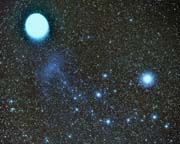
I also took a sequence of 10 x 1 minute RAW frames (mid sequence 2220 UST) which produced this more aesthetically pleasing image, still with the detached tail faintly visible. The bright star is of course Mirphak - alpha Persei. This is probably my favourite image of the comet to date.
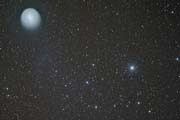
The next opportunity came three nights later, this image being a composite again of 10 x 3 minute frames with the Canon on the ZS66 with 0.63 reducer. Measurements of previous images show the actual reduction to be in the region of 0.72, giving a true focal length around 280 mm. Mid sequence 2345 UST 11th. November 2007. Cropped from the full size image, and stretched to show the remnants of the tail.
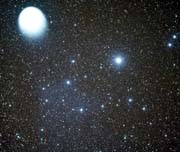
And the full frame, less stretched, warts and all! (Slight amp glow, vignetting and distorted stars in the corners).
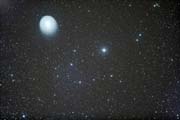
Here is the appearance on 14th. November, 10 x 3 minute frames, Canon 350 D as above. The remains of the ion tail now fading. Mid sequence 2250 UST.
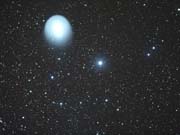
And again on 16th. November, the tail now virtually invisible. Mid sequence 1640 UST
The coma will cover Mirfak in a couple of days' time. Unfortunately the weather forecast for those days is absolutely dire!
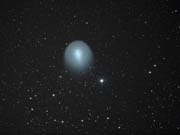
Despite terrible weather over the days of 17-19 November, continuous rain and 100% cloud cover, by keeping a close eye on the satellite weather images I had a slight hope of seeing something of the comet around midnight on 19th. I was particularly anxious to capture an image at this time, because the comet was passing in front of Mirfak - alpha Persei.
And sure enough nature briefly smiled on me with a short interlude of relatively clear although misty sky shortly after 1 am (0100 UST) on 20th. November. And I was able to capture 15 x 1 minute frames with the Canon 350D and William Optics ZS66 with 0.63 reducer with this result. Large size
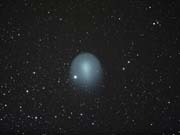
Here is a montage of my images showing the positions and sizes of the comet to date. Poor weather prevented me obtaining an image between 31st October and 5th November. More to come, weather permitting. This image appeared in the December 2007 and January 2008 BBC TV 'Sky at Night ' programmes, and also featured in the February 2014 French Astronomie magazine. It was again used in June 2015 to illustrate a theory by American astronomer Samantha Lawler. See poster here.

Although I managed a couple of shots on 23rd and 25th November, a bright Moon and haze robbed them of contrast and detail, so not worth showing. But a good clear spell early in the evening of 29th yielded this shot. Canon 350D, William Optics ZS66 with 0.63 reducer. 10 x 90 second subs. Cropped a bit, still some coma on corner stars.
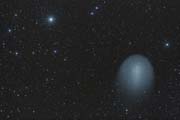
I overlaid the comet on a Skymap chart (using 'Difference' in Photoshop to clearly show the star overlays), and measured the width of the coma. As you can see it's around 47 arc-minutes. Which at the (Skymap provided) distance of 252 million Km works out at 3.445 million Km (2.15 million miles). And the length is of course even greater. So now well over twice the actual size of the Sun!

The night of 2nd December 2007 was clear for several hours, and I was able to take a set of sub frames of the comet with three hours between each set. There was then enough movement to construct a stereo pair. (As always, click on the image for a larger version).
As I mentioned in an earlier image these are intended for the 'wide eye' method of stereo viewing. To remind you, gaze at a point midway between the two images, then try to relax your eyes as though looking into infinity. Then for many, the brain will fuse the two images to give a 3-D effect. It doesn't work for everyone! Some people see the effect reversed, so there are two sets - the vast majority will see the comet floating in front of the stars in one or other of the pairs.
Hint for those who have difficulty with the above : Get a piece of thin card or stiff paper (A4 size will do for most). Position it on the image with your nose just touching the outer end so that each eye can only see the corresponding half of the image. Then you've a better chance of achieving a merge. Once you've got the merge you should be able to take away the card without losing the effect.
But if all else fails, get out those red/blue stereo glasses and view the third image which is an anaglyph. It's rotated to put the movement of the comet horizontal for best effect.

The following night (3rd.) was clear for a few hours in the early evening and I was able to catch the comet again, this time with a longer focal length (Canon 350D and WO ZS66 without a focal reducer, cropped to minimise coma in corners), better to show the nearby open cluster NGC 1245. A reasonable size cluster at 8 arc-minutes, but dwarfed by huge Holmes, now 55 arc-minutes across. Which converts to over 2 1/2 million miles across - almost 3 Solar diameters!
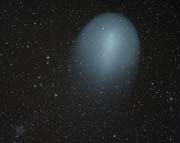
Friday 7th December 2007 was a good clear night and I had another opportunity to take two sets of images separated by approximately 3 hours. This time 10 x 90 second frames with the Canon 350D and the WO ZS66 but using the Astrophysics 0.7 reducer.
So again an anaglyph requiring stereo glasses, produced as for the one above using Anaglyph Maker - freeware from http://www.stereoeye.jp/software/index_e.html
Again NGC 1245 is visible in the lower left corner.
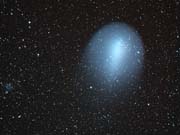
This comet is now so huge and moving so relatively slowly that days elapse between images sufficiently different to be worth acquiring. This one is from around midnight 11/12th December. Again the Canon and WO ZS66 with reducer. Still NGC 1245 in the left of the frame, and the comet now 58 arc-minutes across, which at its distance of 165 million miles makes it a little over 2 3/4 million miles wide! Note the small galaxy NGC 1169 just covered by the lower edge of the comet.
The night of 13/14th December was again clear, but I had unfortunately damaged my main mount. However I was able to mount the Canon on my EQ3-2 mount and take this wide field image with an 18 mm camera lens. Many interesting targets in the field!
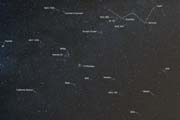
A waxing Moon and poor weather intervened, and I wasn't able to acquire a decent image until December 29th. Here it is, the comet bigger than ever and now requiring sub frames of 2 1/2 minutes. As before, Canon 350D and WO ZS66 with 0.7 reducer.
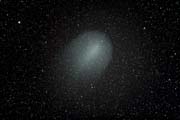
With the above image overlaid on Skymap, I determined the angular size as 67 arc-minutes. At a distance of 183 million miles, the width of the coma is now over 3 1/2 million miles!
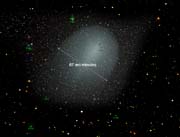
The next opportunity, governed as usual by poor weather, came on 7th January 2008. The comet is now starting to fade and the expansion has slowed right down. Canon 350D, WO ZS66, AP reducer, 10 x 2 1/2 minute sub frames at ISO 800. Larger image
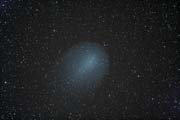
Here the above image is overlaid on a Skymap display. Most of the small galaxies shown are just visible in the image. The coma is now 3.9 million miles across!
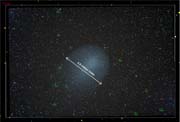
On 22nd January the comet will pass close by Algol - the 'Demon Star' in Perseus. Unfortunately a Full Moon that night, so with the comet now fading it's unlikely that a decent image will result. Here is a shot from 10th January with Algol in the lower part of the picture. Only 7 x 2 1/2 minute sub frames captured before clouds intervened, setup as for 7th January. Larger image
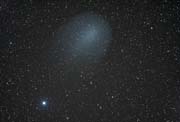
After some more terrible weather (with severe flooding in the South of England) a brief clear spell in the early evening of 16th January 2008 gave me an opportunity to image Holmes again as it closed on Algol. Unfortunately by now the Moon was at first quarter and only 25 degrees from the comet, so although the sky was reasonably clean, there was still enough glow from moonlight to reduce the contrast and mask the by now quite faint coma. Nevertheless it's clear that the coma just covered Algol.
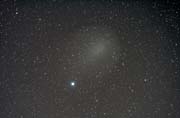
More bad weather , the only clear night typically being Full Moon and then only for a short while. But on January 27th I had an opportunity before the Moon rose and forecast clouds arrived. Even so I had to catch a 'window', and unfortunately I found when I came to process the images that the focus had shifted slightly so the stars are slightly bloated.
And the clouds had by then arrived, so I was unable to try again, or capture an extra wide field shot to build another montage with all my images in. Maybe the last chance for the comet which now measured 4.5 million miles across. No wonder it has now faded considerably, although still just visible in binoculars. Larger image
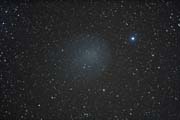
The 1st of February saw the comet well past Algol and still fading. Hardly surprising - it is now almost 5 million miles across!
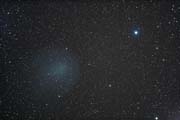
A spell of atrocious weather prevented any imaging, but eventually a clear spell gave me an opportunity on 10th February 2008. Very faint now, and it looks as though the hoped for second outburst isn't going to happen. So I guess that's it. For now.....
